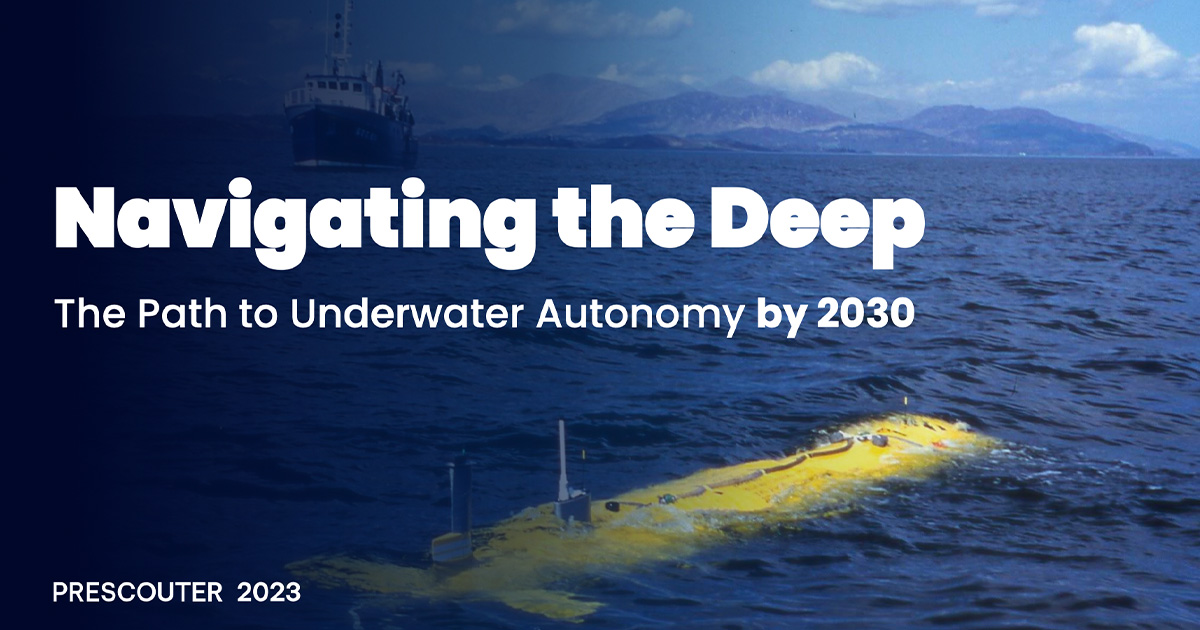PreScouter, a Chicago-based research intelligence firm, partnered with a leading global defense company to explore the future of underwater autonomy. The research has been made public and is titled: Navigating the Deep: The Path to Underwater Autonomy by 2030.
While autonomous underwater platforms (AUPs) are advancing, the journey towards complete autonomy is far from complete. PreScouter sees this report as a holistic overview of the space and a valuable resource for defense, automotive and military organizations.
“Underwater autonomy is on the rise as our patent analysis reveals with a 10-fold increase in the past 7 years. Despite progress in achieving autonomy for underwater platforms being in its nascent stages, leading players globally are currently focusing on overcoming limitations,” notes Dr. Sofiane Boukhalfa, PreScouter Technical Director and report co-author. “Advancements in specialized chips and neural networks, as well as the collection of underwater sensor data to train the neural networks, are key for achieving autonomy,” adds Boukhalfa.
The report looks at the limitations of today’s AI engines for underwater applications, the tools, and data sets to support the development and training of a functional AI engine, relevant advancements in the space and a 20-year patent landscape analysis. An interesting finding of the patent analysis revealed that NVIDIA has filed the most patents in the past 4 years in the field of autonomous underwater platforms.
The PreScouter analysis was complemented with expert insights from AUP engineers. One expert noted that “cloud computing is not a realistic option for underwater platforms, especially if you're not planning to use expensive wideband satellite communication. The key to effective processing is edge computation, and it's essential to have the necessary hardware onboard.” This aligns with NVIDIA’s push to dominate the GPU space to develop the hardware needed to handle the significant volume of data processing required in real-time underwater scenarios.
Key Highlights from the Intelligence Brief:
- A significant financial investment between $5M and $10M is necessary for updating training data specific to underwater conditions, such as labeled image and sonar data sets.
- To evolve the current best-performing platforms to full autonomy, an estimated $100M investment is required.
- The handling of "noisy" data and the need to boost system latencies by 30X for efficient processing and decision-making capabilities.
- Achieving real-time communication protocols, enhancing bandwidth, and robust signal transmission are pinpointed as vital improvements for underwater AI systems.
- Hardware advancements and top-tier edge computing chips are essential for managing the processing demands of autonomous underwater operations.
- Despite current advancements in AI models and deep learning algorithms, a minimum of 7 Technology Readiness Levels (TRLs) improvement is necessary to achieve continuous autonomy.
“Our analysis indicates that by 2030, underwater autonomy will come to fruition, and we highlight what the path looks like. These advancements will not only revolutionize underwater autonomy, but the autonomous vehicle space as a whole as self-driving vehicles have similar challenges to overcome, particularly for use cases in extreme environments,” concludes Boukhalfa.





